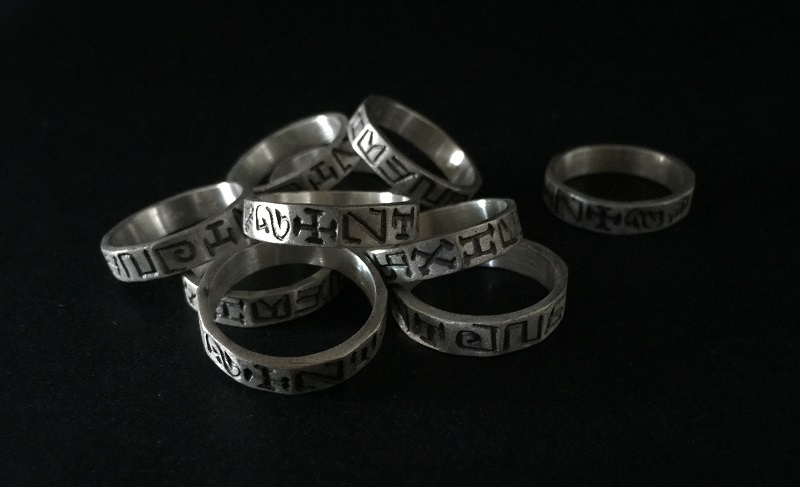When in February 1898 the landowner Emil Schreiber from Paussnitz in the district of Meissen tried to dig a hole in a tree on his property, he could not believe his eyes at first: the shards of a ceramic vessel lay in front of him – and inside a small treasure of silver. Over 500 silver coins from the 12th century, as well as a rather inconspicuous small silver ring - which would later become famous as "the magic ring of Paussnitz" - finally came to light.
The landowner sold almost all of his coins to collectors, but he wanted to keep the ring as a souvenir. Only after long negotiations and haggling and at the urging of what was then the Provincial Museum of the Prussian Province of Saxony (today the State Museum of Prehistory in Halle) did he finally sell the remaining 7 coins, the shattered treasury and that very ring to the Saxon museum for a total of 15 marks.
Since the magic ring from Paußnitz was originally part of a larger coin treasury, it was only registered in the very extensive coin inventory of the museum at the time and finally stored in the huge coin safe of the museum depot. There he fell into oblivion for almost 100 years and was even considered lost in the end.
It was only after more than 100 years that the archaeologist Dr. Arnold Muhl surprisingly found the ring in the middle of the museum's large coin collection during his research for an exhibition in 2002 and immediately recognized its uniqueness and extraordinary rarity. The reason for this is the obvious magical meaning of the inscription on this ring.
At first, the ring's inscription could not be deciphered. Only father and son Rohrer-Ertl finally succeeded in deciphering the inscription on the ring in 2004. It reads something like “NAINE MI XPS” (“Nay me, Christ”) and was certainly an expression of the deepest medieval religiosity and devotion. The original owner was probably a highly educated man, perhaps even a participant in one of the crusades.
The magic ring of Paussnitz is currently at the center of a special of State Museum of Prehistory in Halle with the title "Rings of Power".
Parallel to this remarkable special exhibition, replicas of the Paussnitz ring are being marketed in the museum shop of the Landesmuseum Halle and we were ultimately awarded the contract to produce these museum replicas.
For the Association of Friends of the State Museum of Prehistory in Halle, which operates the local museum shop, it was important to offer high-quality replicas of the “Ring von Paußnitz” that are largely true to the original in all desired ring widths.
In order to achieve this high standard, only the most modern processes were used from the start:
First, a 3D scan of the original ring was made using a high-resolution laser line scanner. This made it possible to transfer the exact shape of the ring to a CAD computer program. With the help of this program, the ring with its original inscription could be precisely scaled into six different ring sizes. The data for these six rings of different sizes were ultimately used to create molds for the detailed casting of the rings on a 3D printer to plot.
The final processing and patination of the ring replicas then takes place in our goldsmith's workshop. To do this, the casting channel from our precious metal supplier is first removed and cleaned up inside the ring rail with a special tool:

Due to the minimal shrinkage when the rings are cast, the smallest deviations are corrected with the help of a ring sizing machine and the exact ring sizes ordered by the museum shop are restored:

Now comes the most complex work step - the patination. For this purpose, the indentations of the originally engraved inscription are blackened with a special chemical that provokes and extremely accelerates the corrosion of silver and thus its blackening. This achieves the same contrasting effect of the inscription that can also be seen on the original ring from the Middle Ages:

Finally, the surface of the ring is adjusted in several work steps to the effect of the ring replicas desired by the museum shop of the State Museum of Prehistory. This corresponds exactly to the appearance of the “Ring von Paußnitz” freshly cleaned for the special exhibition “Rings of Power” in its current state in the exhibition display case.
In this way, the customers of the museum shop in Halle receive a copy of the Paußnitz ring that is almost true to the original – even if the ring is requested with a larger or smaller ring width than the medieval original.
As a final step, each ring replica is stamped with the silver grade stamp “925” for sterling silver and with our personal studio hallmark in order to prove to the museum shop customers the high standards of quality and craftsmanship of these special museum replicas.
In any case, we are very pleased to be able to supply a museum shop of a renowned state museum with our high-quality replicas reliably and within the agreed deadlines with this order - especially since the prototypes of our replicas presented in the desired ring widths by the Förderverein des Landesmuseums Halle without any change requests as a future standard were released immediately.
The fact that we received a first repeat order immediately after the opening of the special exhibition "Rings of Power" shows us that the extensive preparatory work and commitment to the quality of our replicas of the important "Ring of Paußnitz" are already bearing fruit...
By the way: The “Magic Ring of Paussnitz” is available here!

